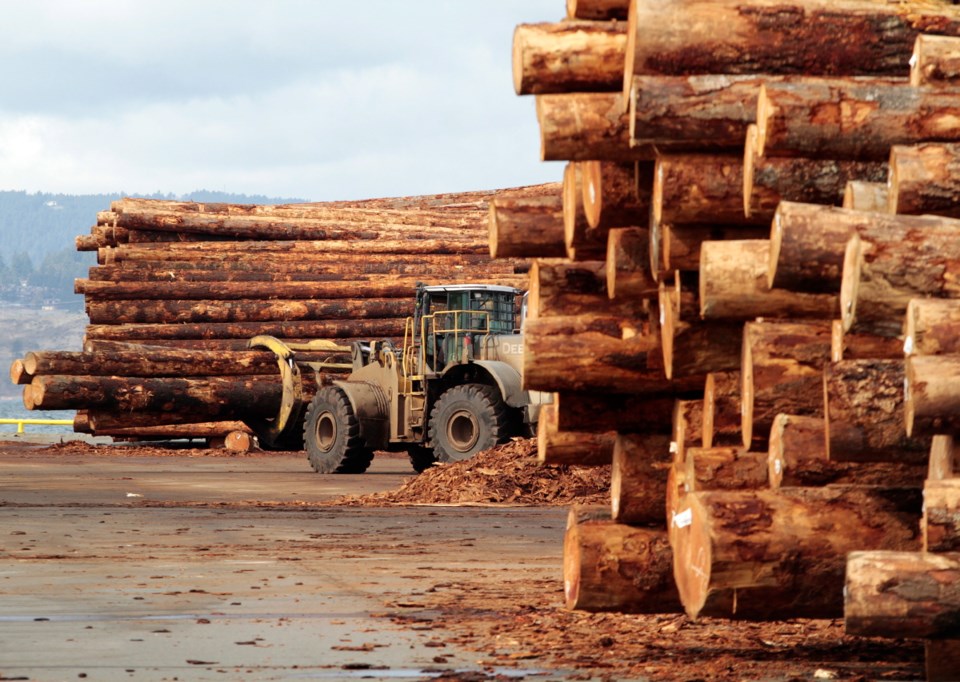Forestry workers and environmentalists gathered in Port Alberni on Friday to call for a ban on log exports and for a transition to “sustainable” second-growth harvests.
But an industry representative says a ban could destroy the coastal forest industry.
Arnold Bercov, president of the Public and Private Workers of Canada, said raw-log exports have resulted in thousands of lost jobs, with more than half of coastal mills closing since the 1990s.
He said existing mills should be retooled for second-growth lumber, which he called the future of forestry in the province.
“Of the 18 mills on the coast, 14 are really tooled for old-growth, even though that is not the majority of wood being cut on the coast. At some point, that is just a recipe for disaster,” he said.
“We’re talking about taking young people’s future and putting it on a boat and moving it off-shore to other countries.”
Bercov said he would like to see forestry companies be required to build mills, as well as legislation limiting log exports.
Torrance Coste, Vancouver Island campaigner for the Wilderness Committee, said B.C. is the only province that exports logs on a large scale.
Exports of second-growth logs are directly linked with threats to old-growth forests, he said.
“Because we’re sending these logs away rather than to mills on the coast, the mills are closing. To keep them open, we have to cut into sensitive areas like the Walbran.”
Sierra Club B.C. warned last week that high and increasing old-growth logging rates on Vancouver Island would lead to an ecological and economic collapse. It found 243,000 hectares of rainforest were logged on Vancouver Island between 2004 and 2015. Of that amount, 100,000 hectares were old-growth.
But Rod Bealing, executive director of the Private Forest Landowners Association, said calls for a ban on exports represent a misunderstanding of the industry.
“My immediate response is: Be careful what you wish for. Because the log export trade, which means the ability to get a fair price for a log, is effectively subsidizing the entire coastal industry at the moment,” Bealing said.
“We would not have any forestry activity on the B.C. coast without being able to access international markets for those logs.”
It’s prohibitively expensive to open new mills, he said. But coastal B.C. is not an attractive place to invest in sawmill technology, due to high labour costs and uncertainty of tenure and fibre supply, he said.
“If you’re not aggressively competitive, you just don’t get to play in the marketplace. And our coastal mills are not globally competitive.”
Roughly one-quarter of coastal available timber is exported, Bealing said, 60 per cent of which is harvested from Crown land and 40 per cent of which comes from private forests.
About 23.5 million cubic metres of coastal forests are available for harvest annually, he said.
Loggers can’t obtain a permit to export logs unless those logs have been deemed surplus to domestic requirements.
“I have to offer them to local mills. And if those local mills make an offer, I have to accept it,” he said.
The coastal processing capacity is about 12 million cubic metres per year. About six million cubic metres are exported and another six million are uneconomical to harvest, he said.
Greig Bethel, spokesman for the Ministry of Forests, Lands and Natural Resource Operations, said typically less than 10 per cent of total provincial harvests are exported.
“The province’s preference is for all logs to remain in B.C. to be manufactured into other products. That’s why all logs are required by law to be offered for domestic sale first, before being considered surplus to B.C. manufacturing needs,” Bethel said.
“When there isn’t a domestic buyer, logs may be exported, often at premium prices. This price premium allows companies to harvest stands that would otherwise be uneconomical to harvest, so more logs are harvested and more logs are directed to B.C. mills as a result.”
The province collected $26 million in log export fees in 2015.



